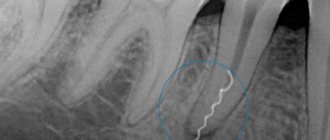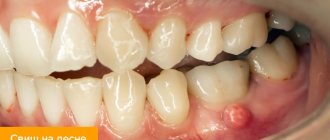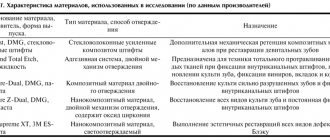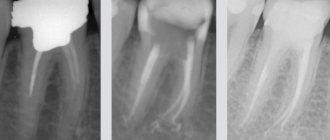Headache after visiting the dentist
Visiting the dentist is a very unpleasant experience. Having headaches after visiting the dental office is a common occurrence. If a doctor removes or prescribes treatment for a diseased tooth, a headache may occur.
The reasons for this may be the following:
- Side effect from medications;
- Severe dental disease;
- Poor oral health;
- A large number of teeth undergoing treatment;
- Poor condition of the body as a whole, the presence of chronic diseases;
- Senile age of the patient;
Most often, pain caused by the cessation of the painkiller goes away on its own. If the pain only gets worse, you need to take an analgesic and consult a specialist for advice.
One of the possible causes of headaches may be the removal of a diseased tooth. Headaches occur especially often when a wisdom tooth is removed (the procedure is not always simple). This type of operation tends to damage bone tissue and gums, which leads to pain.
When correcting a malocclusion, headaches often appear. Pain can be of various types:
- Pain in the ear area;
- The occurrence of pain in the temporal part of the head;
- The occurrence of pain in the occipital part;
If you follow clear treatment instructions, this type of headache goes away in a short time.
Causes of pain during dental procedures [1]
In dentistry, painlessness is one of the basic components of successful procedures. This is due to the fact that in the maxillofacial area there are a lot of nerves that are close to the brain, pain centers. It’s not for nothing that toothache is considered one of the most painful and severe pains. And it was also not without reason that in former times people were afraid to visit dentists: dental anesthesia was then imperfect, and the “freezing” process itself was accompanied by pain. Today, the topic of choosing anesthetics for teeth is very relevant for doctors and patients of dental clinics: minimal harm, safe composition and objective reviews are important.
The purpose of pain relief in dentistry is to interrupt the transmission of irritation from the site of pain during treatment (injection, pressing, drilling, tooth extraction, drug administration, etc.) to the corresponding focus in the brain. The function of the central nervous system is preserved, but the sensitive receptors in the oral cavity simply stop transmitting the signal along the nerves to the brain - they seem to be frozen.
Pain is a special reaction of the nervous system, designed to protect the body and give signals of trouble. All parts and organs of the body are involved in its occurrence. There are 10 cranial nerves in the maxillofacial region (there are 12 in total), and each of them is connected with several other organs and tissues - eyes, ears, muscles, etc. Irritation of one, even the smallest branch of a nerve passing through the site of a dental intervention, injection, will inevitably result in pain and discomfort, and often disruption of the functions of the body and its individual organs. A person without anesthesia begins to behave in the dentist's chair accordingly: he becomes nervous, cries, covers the place of pain, and refuses to give access to it. This is called “operational difficulty”, and it becomes the main reason for ineffective treatment, its impossibility.
Headaches after using anesthesia
Very often, dentists use local anesthesia when treating teeth. After undergoing anesthesia, many patients experience headaches. There are several reasons for this type of pain:
- Presence of intolerance to anesthesia or incorrect choice of medication;
- Location of the diseased tooth in remote places;
Most often, the headache is aching in nature and tends to increase when moving the head.
If headaches began after the extraction of a diseased tooth, it is necessary to find the cause of the pain; it may be a complication of the operation.
Difference between general and local dental anesthesia [1]
The condition when only local pain sensitivity in the part where the intervention is performed is “turned off” is called local anesthesia. Unlike general anesthesia, with such anesthesia the person remains conscious, can communicate with the doctor, perform the necessary actions (open or close the mouth, sit under a special lamp).
General anesthesia is also used in dentistry. But general anesthesia for dental treatment is rarely used and only when necessary, for example, in complex surgical cases or for certain diseases, when the patient’s condition does not allow him to undergo treatment under local anesthesia. When and what anesthesia should be used in a particular case, the doctor decides on an individual basis.
Headache due to complications arising after dental intervention
Many patients experience headaches after visiting the dentist. Various factors can contribute to the appearance of pain symptoms:
- The appearance of complications that manifested themselves during dental treatment;
- Intolerance and allergic reactions to the use of drugs;
- Contraindications to tooth extraction;
- The appearance of a specific odor in the place of dental treatment;
- The presence of inflammation of the tissues of the oral cavity;
- The presence of swelling of the oral tissues;
Most often, pain occurs in several places. They begin in the jaw and gradually spread throughout the head. Painful sensations can be either sharp or aching. Complications after going to the dentist may depend on the presence of certain diseases in the patient:
- Very often, pain appears in patients suffering from diabetes. The headache may last for a long time;
- Ear disease, which can progress during dental treatment and cause headaches;
- Delay in contacting a specialist, which results in severe diseases of the teeth and gums, which are accompanied by painful symptoms of the head;
After symptoms of complications occur, you must go to the hospital to prescribe effective treatment. The occurrence of headaches may be due to the progression of certain dental diseases. Such as:
- Periodontitis – aching pain occurs in the temporal parts of the head;
- Alveolitis - severe pain occurs that begins in the jaw area;
Possible complications
Complications after implantation can be early and late, which appear much later than the day when the operation was performed. The latter can appear even after one or two months. The following body reactions are considered absolutely normal: swelling at the intervention site, pain, slight increase in temperature, slight chills, weakness and drowsiness, and the appearance of a hematoma.
To prevent the development of more serious complications, the doctor must adhere to a specific treatment protocol and act in conditions of absolute sterility. The final result of treatment also depends on the patient, so he must follow some recommendations. For example, at first you should not smoke or drink alcoholic beverages. It is also necessary to take medications prescribed by a specialist, this will reduce the risk of inflammation and pain.
After the operation, cold should be applied to the place where the implant was implanted. It is also worth rinsing your mouth with special solutions with an antiseptic effect. It is very important to remember to regularly brush your teeth, floss and rinse after every meal. For a while, it is recommended to give up strong coffee and tea, visiting the sauna and staying in the open sun. During the period of osseointegration, it is extremely important to lead a calm and measured lifestyle, then the likelihood of headaches and other complications will be minimal.
previous post
How long can you walk without a tooth before implantation?
next entry
Headaches after dental implantation
Pain may occur during the recovery period and after dental implantation surgery. Patients usually experience headaches for several days after surgery. The cause of pain is inflammatory processes in the tissues surrounding the implant. For severe pain, the doctor will prescribe a painkiller. If the pain does not go away within five days, you should contact a specialist who will check the implants for surgical complications and prescribe appropriate treatment.
Types of reactions to pain [1, 2]
The way a patient feels pain depends on many reasons. The main ones are:
- the intensity of the factor that caused the pain and the body’s reaction to it;
- psycho-emotional state of the patient.
The first is a sensitive reaction to pain. When a dentist performs any manipulation, sensitive receptors are turned on and a cascade of reactions develops from the endocrine system, parts of the central nervous system, and the brain. The patient is aware, feels pain and “gives” appropriate reactions to it.
The second point is reactions that depend on the psycho-emotional component, on the data of the volitional sphere. A person experiences fear, anxiety, nervousness, and physical and motor manifestations in the form of screaming, crying, and defensive actions. The pulse and breathing become more frequent, profuse sweat is released, the mouth becomes dry, the regulation of vascular tone is disrupted, and subsequently blood pressure increases or decreases.
The fight against pain in dentistry is necessary not only to eliminate pain for the sake of the effectiveness and comfort of therapy. This is also important because pain, its anticipation, as well as the consequences of a painful intervention cause severe stress, which affects the state of the body and affects further adherence to treatment.
Treatment methods for headaches after dental surgery
If you have a headache for a long time, your dentist will prescribe treatment using the following medications:
- Anti-inflammatory drugs - help relieve inflammation;
- Analgesics – eliminate pain;
- Antispasmodics – relieve spasms that cause pain;
If the cause of pain is inflammatory processes in the oral cavity, then the presence of toxins, which are eliminated by the use of antibiotics, should initially be eliminated, and only then the prescribed medications should be used.
Taking such medications must be done under the supervision of a physician. The use of such drugs is contraindicated for patients suffering from stomach diseases.
Headache - check your teeth: nine naive questions to the dentist
In fact, you need to take care of your smile not before spring or some other season, but throughout your life,” says our interlocutor, dental therapist Denis Nazirov. But if for some reason you couldn’t do this before, now is the time.
|
| The Lana dental clinic, headed by practicing dentist-therapist Denis Nazirov, is a family enterprise. “In 1988, my parents and aunt organized one of the first private dental offices in Yekaterinburg. Our clinic was founded on its basis, and in March we are celebrating its thirtieth anniversary,” says Denis. |
— What does your “dental care” mean: is it a visit to a hygienist, whitening, or is it enough to just brush your teeth twice a day?
— Any care is built according to the scheme from simple to complex. Brushing your teeth twice a day - in the morning after breakfast and in the evening before bed - is a necessary hygiene minimum. I note that if you have the opportunity to use a brush and toothpaste in the middle of the day, after lunch, it is better to do so.
The next mandatory item is visiting the dentist. This should be done once every six months, regardless of age. In fact, as soon as teeth appear, you immediately need to start preventing their diseases.
— Go to the doctor if nothing bothers you? This smacks of siphoning money... Dentists have always been considered one of the most expensive doctors.
— You know, the relationship here is rather the opposite: the more regular your visits to the dentist, the less money you will end up spending on your teeth. Any dental disease is progressive in nature. The longer a person suffers from a problem, the more expensive the treatment will be later.
One of the features of dental diseases is that... that many of them go unnoticed. The cavity looks fine: pink gums, white teeth. But one not at all wonderful morning a person wakes up, and he has a gumboil. Why? But it turns out that he has been developing a granuloma for some time - this is a change in bone tissue. In the spring, such cases are especially frequent: a person’s immunity decreases, and chronic diseases that were hidden begin to manifest themselves. Including dental problems.
|
| “Now it is possible to practically grow new teeth - we have the following technologies: we can completely restore chewing functions and restore the dentition with all missing teeth, on four implants. But it's expensive. Prevention will definitely be cheaper,” Denis is sure. |
- By what signs can this be noticed - except for gumboil, of course.
— I repeat: this is not entirely the right approach - rushing to treat teeth when the problem has already become obvious. Prevention is always cheaper. But if you suddenly avoid dentists for some reason, there are several signs that clearly show that the appointment cannot be delayed any longer. First of all, this is the reaction of teeth to temperature: increased sensitivity to cold or heat. The same applies to the reaction to sweets. Well, if there is pain when biting or there is a feeling of an overgrown tooth - here, without any questions: hands to feet and go to the appointment.
By the way, in Western countries, a patient who goes to the hospital with complaints of allergies or, say, a headache, will first of all be sent to the dentist for a certificate of oral sanitation.
— How are headaches and teeth related?
- In the most direct way. Let’s say a person has lost a tooth for several years. During this time, he completely adjusted and learned to chew taking into account this loss. But the teeth adjacent to this missing one change their position, shift, the bite changes, some movements during chewing are blocked, the load on the joint, on the muscles changes, they are in constant tension. The result is a headache.
In general, everything in the body is connected. And teeth, no matter how trite it may sound, are the gates of the body. Every now and then, while examining our patients, we send them for consultations with other doctors. Most often - otolaryngologists: diseased teeth, as a rule, provoke diseases of the paranasal sinuses. Problems with the gastrointestinal tract, with the endocrine system - all this also affects the teeth.
|
| “After we equipped the clinic with a computed tomograph to perform dental imaging, several people were diagnosed with oncology in the oral cavity - in this case, of course, we carry out our treatment only after consulting the patient with the specialists of the Oncology Center,” says the director of Lana. |
— For many, a visit to the dentist is something like voluntarily going to an inquisitor...
“Many people really feel afraid of the dentist. But, in my opinion, in recent years this stereotype has begun to go away. People take a more responsible approach to their health in general and to oral care in particular. This is largely due to constantly improving technology. Previously, dental treatment was not so comfortable and painless. Now you can treat your teeth under anesthesia or sedation. This is especially true for children - it is not possible to establish a dialogue with everyone, although our doctors try to do this: by the way, we are focused on family treatment. True, in our clinic it is not yet possible to carry out procedures under anesthesia - this is in the plans for the coming year: to equip an operating room.
As for fear, I think another reason is that patients were not given so much attention before. For example, in our clinic we try to create a homely environment: we have girls-administrators - such hostesses, they will greet you and offer you tea and coffee. But for me, the clinic is a home: “Lana” is located in the apartment where I lived as a child. In the office where I now see patients, I once did my homework.
|
| Now the dentist’s office does not resemble the children’s room that once was here: high-tech dental equipment, including a laser and microscope, modern consumables - according to Denis, one cannot do without this in the current highly competitive market. |
— When communicating with dentists, as well as with other doctors, fear and mistrust also arise from the fact that doctors often begin to throw around terms or say: you need to do this and that, but it is not clear why this is so. Maybe they just want more expensive treatment so they can put more money in their pocket.
- You are absolutely right! This reason is one of the main barriers between the doctor and the patient. We ourselves are constantly faced with the fact that some of our specialists are sometimes, let’s say, too specialist: they are used to speaking in complex medical terms, and clients cannot always perceive these terms. We recently introduced a curator position in our clinic - these are people who do not have a medical education, but have been working in the clinic for a long time and know everything about our technologies. They help the patient understand all the intricacies and nuances of medical practice. They can explain, say, the difference between a crown and an inlay, or draw up a financial treatment plan, advise a specialist, and so on.
|
| The 3D scanner is one of the high-tech devices that the director of Lana mentioned. “We scan the oral cavity in different projections, create a 3D model and, based on it, make impressions and transfer them to our dental workshop. The patient does not need to come to us several times for us to make high-quality prostheses for him - thanks to this 3D model, everything can be done remotely,” explains Denis. |
— You talked about high competition in the market. How have you managed to stay afloat for 30 years?
— Have you seen our employees? These are mostly young professionals. And since they are young, that means they are greedy for knowledge. They are constantly learning something, constantly on the topic of some kind of know-how. Therefore, we do not ignore new technologies. Sometimes I don’t know, but they know: they come, tell, show, prove that we definitely need this. As a result, we are introducing this technology.
|
| Dental treatment under a microscope is another technology that can minimize pain and fear of dentists. “When I first saw the microscope, I was so inspired that literally a couple of months later such a device appeared in our clinic. This technology allows us to minimize the risk of accidental damage to healthy tissue during treatment and ensures very high accuracy during filling and grinding,” says Denis. |
“But if they are young, they have, accordingly, less experience.
“We find our doctors when they are still in their final years of medical school. At first, they work as assistants, training on a mannequin - for example, treatment under a microscope requires a significant restructuring of their minds and retraining of their hands. Only after serious practice on models do they begin to treat patients. In addition, we also have specialists with extensive experience - the patient can choose who to entrust their health to. I am sure: one of the most important channels of promotion in dentistry is recommendations: you liked it, you brought a friend, he brought his wife, and so on.
|
| Word of mouth, ongoing training and new technologies - according to Denis Nazirov, these criteria should be the main ones for patients when choosing a clinic. “Well, the price. But we must understand that training and technology require investment. And not a single private clinic will operate at a loss. It’s better to pay a little more, but get quality teeth for the rest of your life. Unless, of course, we forget about prevention,” Denis laughs. |
— In addition to a preventive examination, are there any other recommendations for those who want to greet spring with a smile?
— You know, the main thing for a smile is a positive attitude. And it is given, for example, by playing sports. I have been involved in rally racing for a long time, and now my son has followed in my footsteps - he is involved in karting. I myself start every morning at the gym, then go to work. So the main thing is to be positive! And then, of course, teeth (laughs).
Relieving pain with folk remedies
If you experience headaches after a recent visit to the dentist, you must first identify the cause of the disease. It is impossible to do this on your own without visiting a doctor. You can use some traditional medicines, but you should consult your doctor before using them.
- Drinking mint tea is good for eliminating cramps and reducing headaches;
- Freshly prepared viburnum juice - drink one hundred grams for headaches twice a day for five days;
- The use of hot foot baths is a proven folk method for relieving headaches;
You should know that the occurrence of headaches after dental treatment may be one of the first prerequisites for the occurrence of more dangerous diseases. Painful sensations mean that inflammatory processes are occurring in the body, so you need to consult a specialist; you should not self-medicate.
Category Miscellaneous Published by kosmetik-dent
For what procedures is anesthesia used [1, 2]
Pain relief in dentistry cannot be overemphasized. So that the patient does not experience discomfort, and the specialist has the opportunity to perform the entire necessary amount of treatment, anesthesia is used for almost all dental interventions. The types of anesthesia in dentistry are varied, and the doctor chooses the method of anesthesia depending on the upcoming procedure.
Modern ideal anesthetic in dentistry:
- Affects as few organs or processes as possible.
- Poorly absorbed.
- Does not have an irritating effect.
- Works quickly, deeply, long lasting.
Based on materials from “Local anesthesia and anesthesiology in dentistry: a textbook”, Ph.D. Krazhan S. N.
Application or superficial local anesthesia in dentistry is carried out using a spray or gel with an anesthetic component. The drug is applied to the mucous membrane and acts quickly, but not for long.
- Before the anesthetic injection
- For treating mucous membranes during stomatitis, suppuration, gingivitis
- When performing professional hygiene
- During crown fitting
Infiltration anesthesia is the administration of an anesthetic using a syringe before therapy. Lasts about 1 hour.
- Treatment of caries, pulpitis
- Root canal treatment
- Removal of nerves
Conduction anesthesia is an injection of an anesthetic drug near a nerve. This “freezing” lasts about 2 hours.
- Treatment of pulpitis, complicated caries, including multi-rooted teeth
- Opening of granulomas, cysts
- Tooth extraction (removal)
Tooth hurts severely after caries treatment: possible causes
Pathological pain in a tooth after visiting the dentist can be caused by improper preparation of a carious cavity or faulty filling technology.
Most often, if mistakes were made during treatment, the patient’s tooth hurts when pressing, tapping, biting, or under the influence of cold or hot food. Less commonly, tooth pain occurs on its own, without external irritants. The duration of pathological pain usually exceeds 5 days and can last for two to three weeks.
The tooth hurts if the following problems arise during the treatment of caries:
- the dentist dried out the carious cavity;
- the cavity, on the contrary, remained under-dried;
- the filling is poorly polished;
- an allergic reaction to the filling material has occurred;
- the process was complicated by inflammation.
Let's take a closer look at each reason.
Overdrying of the carious cavity
After removing caries (softened, diseased tissue), the dentist prepares the cavity for installation of a filling. In order for the filling material to adhere well to its walls, the carious cavity is etched with a special acid composition. Then it is washed off and adhesive is applied to the walls - it ensures better adhesion of the material. Before applying the adhesive, it is very important to dry the tooth walls well, but not to overdry them. If you treat the cavity with a stream of air for a long time, small nerve endings located in hard tissues are damaged. It is their damage that causes the tooth to hurt after caries treatment. In the most severe cases, when the cavity becomes too dry, inflammation of the dental nerve may even develop, and then it will be necessary to depulp the tooth and fill the canals.
Poor cavity drying
The opposite situation - when the cavity is not completely dried before applying the adhesive - can also cause pain. In this case, due to the large amount of moisture, the adhesive cannot properly saturate the walls of the cavity, and, as a result, the filling does not adhere well to them. After drying, the composite material decreases in volume, pulls the adhesive with it, and the latter moves away from the walls. Cavities appear inside the tooth and irritation of the nerve branches occurs. In addition to pain, the filling often also falls out.
Poorly polished filling
If the filling is not polished well enough, is too high and interferes with a normal bite, there is strong pressure from the opposite tooth on the filling. The latter, in turn, puts pressure on the sensitive pulp. The nerve endings in it become irritated, and the person experiences throbbing pain. The only way to fix the problem is by re-grinding the filling.
Inflammatory process
If, when treating deep caries, the dentist overheated the dentin, damaged the bottom of the pulp chamber, and pathogenic microorganisms managed to penetrate into it, acute pulpitis may develop. The inflammatory process in the pulp reveals itself with acute, increasing, self-occurring pain, which intensifies at night. After a few days, the pain may subside and become less acute, but this means that the process has entered a chronic stage. If you do not seek help from a dentist in time, an even more serious complication may develop - periodontitis. With this disease, inflammation covers most of the tissues surrounding the tooth and can result in the formation of a cyst.
Allergic reaction
Sometimes, after caries treatment, not only does the tooth hurt, but other symptoms appear - skin rash, discomfort, strange (bitter or sour) taste, stomatitis, redness and swelling of the gums. As a rule, these are signs of an allergy to the filling material. It contains dyes and preservatives, so people prone to allergies may react to these components. In such a situation, the only way to get rid of pain is through retreatment.
Treatment of odontogenic trigeminal neuralgia
Therapy usually involves a combination of medications and physical therapy. At the first stage, patients are prescribed non-narcotic analgesics. If an inflammatory process is present, then it is recommended to take anti-infective drugs in parallel.
Physiotherapy at this stage may include:
- modulated currents,
- ultrasound,
- Ural Federal District,
- moderate heating.
After the pain subsides, they move on to the second stage of treatment. At this stage, electrophoresis of novocaine or calcium chloride is recommended. If the process is inflammatory, then phonophoresis with hydrocortisone is prescribed. In addition, it is important to begin treatment for the dental disease that caused the problem.
At the last recovery stage, biostimulants, treatment with mud or paraffin, and local use of ozokerite are useful.
Pain after fixing the prosthesis on the implant
Sometimes patients complain that the implant hurts after installing a crown. In fact, an artificial root cannot hurt, since it is a non-living structure. Discomfort after fixing the crown on it can only occur in the area of soft gum tissue. Causes of this pain:
- incorrect preparation for prosthetics;
- production of a crown in violation of technology;
- incorrect installation of the prosthetic structure;
- violation by the patient of the doctor’s instructions and prescriptions.
Any pain after implant installation that greatly bothers the patient should be a reason to immediately visit a doctor. With timely treatment, it is possible to quickly stop the problem and prevent more severe complications.
What other possible complications are there?
Complications after dental implantation are classified into early and late. The first includes symptoms that arose in the first two days, the second - after a month or more.
Normal reactions to surgery include:
- pain,
- swelling,
- increase in body temperature,
- hematoma.
However, sometimes there are more serious problems that require urgent help, otherwise removal of the implant cannot be avoided:
- Long-term pain - if the discomfort does not go away for more than a week, you need to determine its cause. The problem can only be solved by a specialist; self-medication is dangerous due to the development of complications.
- Increased body temperature - readings above 38 degrees should alert you, they may indicate an inflammatory process has begun.
- Numbness - in the first hours after surgery, lack of sensitivity is normal, since the effect of the anesthetic is still ongoing. Prolonged numbness may indicate injury to the trigeminal nerve.
- A feeling of heaviness in the maxillary sinus occurs due to the implant falling inside it. This is a specialist mistake when calculating the required length of a titanium rod. The situation requires the removal of the structure.
- Peri-implantitis is the initial stage of implant rejection; it can develop at the very beginning of engraftment and after its completion. The provoking factor is inflammation of the soft and bone tissues of the jaw. The reason is usually a violation of the surgical protocol on the part of the doctor or failure to comply with the rules of oral hygiene on the part of the patient.
- Rejection is an advanced stage of the inflammatory process, when treatment will no longer produce results.
Opinion of a dentist-implantologist : “In my practice, there were several cases when patients complained of headaches after the end of the prosthetics stage. For the most part, it was associated with increased load on the crown at a certain position of the lower teeth to the upper ones. If there are intense, persistent pain in the head after implantation, trigeminal neuralgia must be excluded.”
Why does the tooth continue to hurt after caries treatment?
There are several types of caries depending on the depth of the lesion. And if superficial can sometimes be cured even without drilling and filling, then with medium and deep, the tooth is always prepared, the carious cavity is cleaned, and a filling is installed. Even the most careful dental treatment in a good clinic results in tissue trauma in any case. Therefore, for some time the tooth aches and hurts when pressed.
In this article
- Why does the tooth continue to hurt after caries treatment?
- Tooth hurts severely after caries treatment: possible causes
- What to do if a tooth hurts or aches after treatment of deep caries?
- How does retreatment occur?
The most common cause of pain after dental treatment is residual symptoms. In this case, pain is a natural reaction of the human body to preparation, treatment of a carious cavity and other manipulations of the dentist. Directly during treatment, there may be no pain as anesthesia is in effect. But as soon as its effect wears off, pain may appear.
Most often, a tooth hurts after treatment of deep caries, complicated by pulpitis and periodontitis, as well as with increased sensitivity of the teeth. In the latter case, the tooth often hurts when pressing, biting, as well as any, even minor, touches.
Such natural pain normally goes away 3-5 days after visiting the dentist. If the tooth hurts longer or the sensation is too sharp and unbearable, you should definitely consult a doctor. The cause may be pathological, in which case it is necessary to detect it as early as possible.











